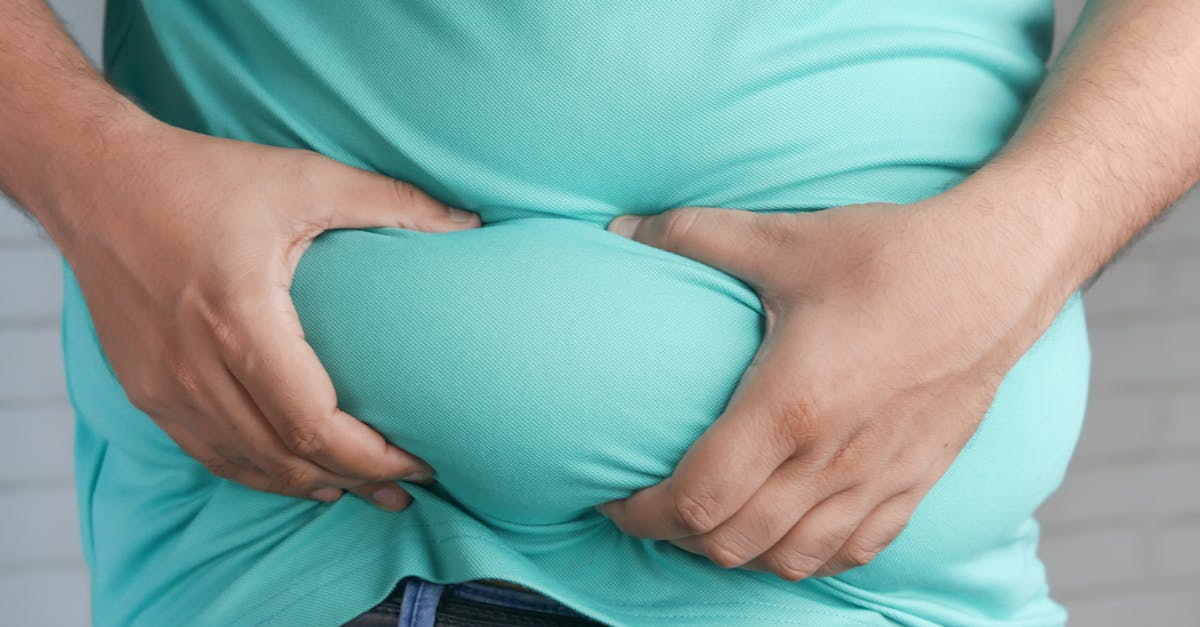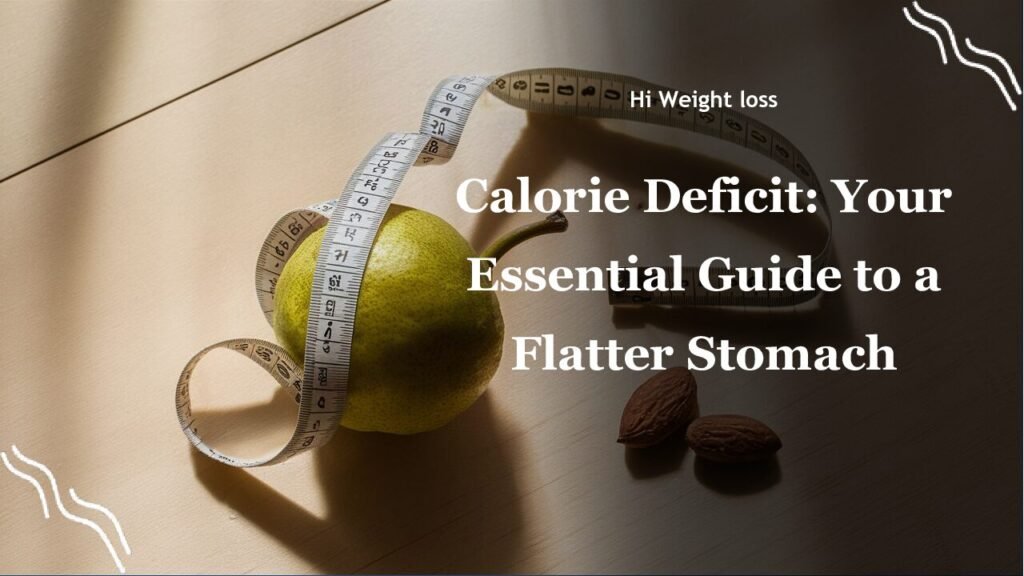Are you tired of that stubborn belly fat and dreaming of a flatter stomach? You’re not alone. Many people struggle with this, often trying various methods with little success. But what if I told you there’s a science-backed approach, a path that can lead you to your goal? This article will explore whether a calorie deficit can truly give you a flat stomach, and what other factors come into play, using evidence and personal insights.
Will a Calorie Deficit Give You a Flat Stomach?
Let’s get straight to the point: a calorie deficit _is_ essential for fat loss, including belly fat. When you consistently consume fewer calories than you burn, your body taps into its stored fat for energy. It’s a fundamental principle of weight management. Think of it like your body’s bank account – if you withdraw more than you deposit, you’ll see the numbers go down.
Understanding Calorie Deficit and Fat Loss
So, how does this all work? A calorie deficit forces your body to use its own fat reserves. When you’re in a deficit, your body doesn’t care where the fat comes from; it’s a system-wide process. This means you can’t specifically target belly fat through a calorie deficit alone.
I remember when I first started on my fitness journey, I thought doing endless crunches would magically eliminate my belly. I was wrong. While exercise is crucial, it works best when coupled with a calorie deficit. It’s about creating the right conditions for fat loss throughout your body.
The Truth About Spot Reduction
You’ve probably heard of the term ‘spot reduction’, which suggests you can target fat loss in specific areas. Unfortunately, this is a myth. Scientific evidence and my personal experience have consistently shown that you can’t choose where your body loses fat first. It’s a genetic lottery.
The body breaks down stored fat for energy when in a calorie deficit, but fat loss is systemic and not localized, meaning you can’t target fat loss in specific body areas like the belly. Your body distributes fat loss according to its own internal rules, influenced by factors like genetics, age, and hormones.
How Long Does it Take to Get a Flat Stomach with a Calorie Deficit?
This is a common question, and unfortunately, there’s no one-size-fits-all answer. The time it takes to get a flat stomach depends on various factors, including your starting weight, your level of activity, and your overall consistency. I’ve seen people make progress in a few months, while others take much longer.
Patience is key here. A slow and steady approach is generally more sustainable and allows your body to adjust. Trying to rush the process can often lead to frustration and burnout. You must create a sustainable calorie deficit which involves making gradual dietary changes. The specific time frame depends on your body’s metabolism and fat distribution, not all bodies lose fat at the same rate.
Now, let’s look at the factors that influence fat loss:

The Role of Diet, Exercise, and Lifestyle
While a calorie deficit is the foundation, it’s not the only piece of the puzzle. A balanced diet plays a crucial role. You should prioritize whole, unprocessed foods like fruits, vegetables, lean proteins, and whole grains. These foods provide essential nutrients and help you feel fuller for longer.
Regular exercise is equally important. It not only burns calories but also helps build muscle, which can boost your metabolism. When I started incorporating a mix of cardio and strength training, I noticed a huge difference in my body composition and fat loss progress. Remember, muscle burns more calories at rest than fat, so building muscle will help you lose fat long-term.
Lifestyle factors also matter. Getting enough sleep, managing stress, and staying hydrated all impact your body’s ability to lose fat. I’ve found that when my stress levels are high and sleep is poor, it’s much harder to maintain a calorie deficit.
Can a Calorie Deficit Alone Give You a Flat Stomach?
Yes, a calorie deficit is crucial, but it might not be the entire solution if your goal is a flat stomach. In most cases, a calorie deficit will result in overall weight loss, but to reveal the underlying abdominal muscles that create a defined stomach, you will also need to focus on overall body composition by incorporating strength training exercises in addition to maintaining the calorie deficit.
In short, while a calorie deficit will reduce overall body fat, the appearance of your stomach is determined by multiple factors and can’t be completely controlled by a calorie deficit alone. The appearance of a flat stomach depends not only on fat loss but also on the strength and size of the underlying muscles, especially the abdominal muscles.
Remember, your genes and hormones influence where your body stores and loses fat, and this affects the overall outcome, and the extent to which a flat stomach can be achieved.
The Importance of a Holistic Approach
So, what’s the best approach? It’s a combination of a well-planned calorie deficit, consistent exercise, a balanced diet, and healthy lifestyle habits. It’s about creating a sustainable routine that fits your lifestyle.
I’ve found that when I focused on these aspects together, I not only lost weight but also felt healthier and more energized. This is not just about the number on the scale, it’s about creating a better version of yourself.
It is crucial to understand that genetics and hormonal balance play significant roles in how and where you lose fat. Therefore, while a calorie deficit is crucial, it should be part of a holistic approach involving a balanced diet, regular exercise, and healthy lifestyle changes.
Tips for Creating a Calorie Deficit
Here are some practical tips to help you create a calorie deficit effectively:
- Track Your Calories: Use a food diary or an app to monitor your calorie intake. This provides data-driven insights into your eating habits.
- Eat Mindfully: Pay attention to your hunger cues and eat slowly. Try to avoid distractions while eating to become more attuned to your body’s signals.
- Increase Protein Intake: Protein keeps you full and helps preserve muscle mass. Ensure that each meal has a source of lean protein.
- Stay Active: Incorporate both cardio and strength training into your routine. Aim for at least 150 minutes of moderate-intensity exercise per week.
- Drink Plenty of Water: Staying hydrated can help with satiety and reduce the urge to snack. Water also aids digestion, and helps to keep your body’s metabolism working smoothly.
- Reduce Processed Foods and Sugary Drinks: These are often high in calories and low in nutrients.
Below is a table with some simple changes you can make to create a calorie deficit:
| Change | Estimated Calorie Savings per Day |
|---|---|
| Switch from regular soda to water or unsweetened tea | 150-200 calories |
| Replace processed snacks with fruits or vegetables | 100-150 calories |
| Portion control at meals (reduce your usual serving size slightly) | 100-200 calories |
| Incorporate a 30-minute brisk walk | 150-200 calories |
| Choose whole-grain options instead of refined grains | 50-100 calories |
Remember, small changes over time can lead to big results. Being consistent is what truly matters.
Conclusion
So, _will a calorie deficit give you a flat stomach?_ Yes, it’s an essential piece of the puzzle. But it’s not a magic bullet. It’s a crucial element that works best when part of a holistic strategy. By combining it with a balanced diet, regular exercise, and healthy lifestyle habits, you significantly increase your chances of achieving a flatter stomach and overall better health. Remember, you have to create the right conditions for fat loss throughout your body. Achieving a flat stomach often involves patience, consistency, and an understanding that spot reduction is a myth.
Think about my friend Sarah, who spent months only doing abdominal exercises with no real results. It wasn’t until she combined these exercises with a calorie deficit, that she began to see significant changes. Her experience, like so many others, underscores the importance of an approach that encompasses the whole picture. So, why not start today? Implement these strategies into your daily routine and take the steps to achieving your fitness goals. Share this article with someone who may be going through this. Let’s support each other on our journeys to a healthier and happier lifestyle.
FAQ
Is it possible to lose only belly fat?
No, you cannot specifically target belly fat loss through diet or exercise alone. Your body loses fat from all over, not just one area. Remember that fat loss is systemic, meaning it happens throughout your body, and the specific areas where it occurs are largely determined by genetics, age, and hormone levels.
How much of a calorie deficit do I need to lose weight?
A safe and effective calorie deficit typically ranges from 300 to 500 calories per day. This will help you lose weight at a rate of about 0.5 to 1 pound per week, which is considered sustainable. It’s crucial to be consistent with your calorie deficit, and it is recommended to consult a healthcare professional to determine what a healthy deficit looks like for you and your body.
Can exercise help me get a flatter stomach?
Yes, exercise is an essential part of achieving a flatter stomach. However, it’s crucial to combine both cardiovascular and strength training exercises. Cardio helps to burn calories, and strength training helps build muscle, which enhances your body’s metabolism. Working your abdominal muscles and core will improve muscle tone and the overall appearance of your stomach. Remember, it’s a comprehensive approach that works best.
What role do hormones play in belly fat loss?
Hormones play a significant role in how and where your body stores fat. For example, high cortisol (stress hormone) levels can contribute to increased belly fat. Hormonal imbalances, such as those related to insulin resistance, thyroid problems, and menopause, can also affect fat distribution. Managing these hormonal aspects is key for sustainable fat loss, and consulting a doctor or healthcare professional to address hormone related issues is crucial.
Is it okay to lose weight rapidly?
Rapid weight loss is not recommended. It can often lead to muscle loss, nutrient deficiencies, and a higher likelihood of weight regain. Rapid weight loss also affects other areas of your health. A slow, sustainable approach to weight loss is usually more effective and much healthier. Always aim for gradual changes and consult with a healthcare professional to ensure the approach is healthy.



